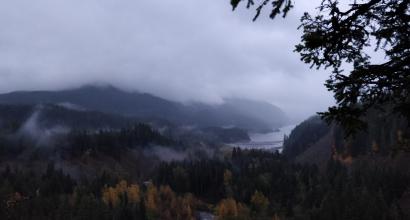A Subtle Concept
The truth explained in this appendix is that of the paramārtha.
We have explained earlier that truth is of three kinds: (1) vyāvahārika — pertaining to worldly life; (2) prātibhāsika : It is seen only in internal experience such as dreams; (3) pāramārthika : This is the sadvastu which remains constant in all places and times. That itself is the principle of the parabrahma. Presently, we are discussing the third one.
Well, are there parts or differences in this great truth? Are there degrees, even?
Parabrahma is single, infinite, eternal. It cannot be cut or divided. Where division is not possible, there is no possibility of quantification or degrees.
However, the human intellect that tries to perceive it is limited, and can only understand it in parts. Therefore, the truth that is understood by him will be in degrees and in parts.
There are no degrees in truth, but in its attainment.
Here, we are not discussing the nature of truth, but about the means to obtain it; not about its form, but the method we are going to adopt to find truth.
Truth is independent, and self-existent. It does not have to conform to our bahiṣpramāṇa or antaḥpramāṇa, but is beyond both. it does not mean that it does not exist if it cannot be obtained by our pramāṇas. It might be derived from some pramāṇa other than ours; or it might remain hidden without ever showing itself. It is not right to argue that it does not exist, just because it is not achieved through our pramāṇas. Even if we cannot see the truth, it exists.
Be that as it may, the pertinent question here is how we can obtain it. Can we give up means such as Vedas and śāstras and understand truth just with our intellectual efforts? Another question arises as an answer to this question. Can we accept what our independent intellectual adventures see as the actual truth? How can we be sure? Since it was obtained by mere intellectual effort and lacks the testimony of other pramāṇas, what do we do if someone calls it an intellectual delusion, or a mad imagination? Can we accept it? Will we not feel doubtful about our view? Thus, another proof becomes necessary. That proof is pramāṇa. Pramākaraṇam pramāṇam — ‘pramā’ means right understanding. The opposite of pramā is ‘bhrama’ or misconception. If we are to be sure that our understanding is ‘pramā’ and not ‘bhrama’, the testimony of the Vedas and śāstras becomes necessary.
If human intellect sets out in search of truth without the help of other means and assumes that what it sees is the truth — the pure, complete and eternal truth — others cannot prove that it is not the real truth. The pramāṇas that others accept have already been disregarded. Thus, there is no common ground for arguments and counter-arguments. It will be as if they are speaking to each other in different languages. Therefore, reasoning between them will be futile.
Only an adventurous intellectual will be capable of discussing whether a darśana obtained by mere intellect is the actual truth or not. This discussion appears to be mere logical squabbling to others. It does not descend into our lives. It is said that in advanced theoretical mathematics, arbitrary numbers are multiplied and divided and new number systems are formed. That is only in the intellectual realm, and does not descend into daily life[1]. The spiritual domain is not like that. To understand the truth here, cooperation with all the aspects of life is necessary along with the intellect. Philosophical deliberation is a special affair.
Bahiṣpramāṇa is enough in worldly sciences. If a physicist publishes a new theory, others can immediately apply it in their work. The theory can then be proved or disproved. The theories of chemists, biologists and medical scientists are similar — they can be established by direct perception or pratyakṣa-pramāṇa.
The truth of Vedanta is not understood merely by direct perception, because its subject is beyond bodily senses. Therefore, the chief pramāṇa to comprehend the truth is personal experience. This internal experience is dependent on the capability of the antaḥkaranas.
tatra taṃ buddhi-saṃyogaṃ labhate paurva-dehikam ॥
-BG 6.43
The mind and intellect undergo various samskāras due to impressions from past lives and the company and practice in the present life. Due to the variety in these samskāras, mental affinities and intellectual capacities vary from person to person. Among āstikas, these differences in the antaḥkarana can be categorized into three :
The happiness obtained by surrendering oneself to the divine
The happiness obtained by partnering with the divine
The happiness obtained by merging with the divine.
- Surrendering oneself to the divine — The jīva finds happiness and pleasure in surrendering himself and all his possessions to the divine completely and always to the divine. This begs the existence of two separate things — master and servant ; worshipper and worshipped; or lover and beloved. There should be two aspects, and should be in ardent companionship with each other. This is Dvaita.
- Partnering with the divine — The jīva becomes a part of the līlās of Bhagavān, and obtains a part of the bliss of divine līlās. There are two stages here : (1) The feeling of master-servant duality during service to the divine; (2) in the bliss that is experienced during this service, the split between master and servant dissolves and they both become one. When a morsel is being mixed[2], hand and mouth are different; when the tongue tastes it, all bodily organs experience pleasure and benefit. This is Viśiṣṭādvaita.
- Merging with the divine — The jīva merges in what it believes is omnipresent and is manifest as all forms in the universe, thus losing its separate existence and identity. This is Advaita.
This explanation of the principles is only a broad overview. The nature of the three matas is explained further.
The important point is this. At the centre of all these matas is the jīva’s svatā - the mental experience of ‘I’. The goal of all three matas is the final destination of this svatā.
Indeed, we saw earlier that the Vedas and śāstras are the common foundation for all the three matas. All the three matas find supportive sentences for their point of view in the Vedic literature. The followers of a specific mata select statements that are in agreement with their view and quote them. What do they do with the others? They interpret them to support their arguments by means of logical reasoning and grammatical contrivances. Dvaitis do not dispute the authoritativeness of the pramāṇa-vakyas from the Śruti that the advaitis base their arguments upon; and they accept the letters of the sentences; but argue that the advaitic interpretation of these statements is absurd and that they should be interpreted in a different way. Advaitis in turn respect the statements from the Vedas quoted by Dvaitis as Veda itself; but they argue that dvaita-interpretation of these statements is inconsistent and that a proper deliberation of these culminates in Advaita. Logic and grammar are favourable to both sides. Smṛtis, purāṇas and itihāsas are also the same. In this cacophony of commentary, however, the real meaning of Vedic statements appears ambiguous. Human ingenuity drags the actual meaning of Vedic statements this way and that. The purport of the apauruṣeya[3] Vedas is made ambiguous by human creativity. What should one do in such cases? He should turn his sight inwards, within his heart. He should deliberate upon it within himself and decide which among the meanings available by the bahiṣpramāṇas is agreeable to him, and hold it tightly. Whether the meaning is that of Dvaita or Advaita or Viśiṣṭādvaita — if a man holds on to a principle strongly and deliberates upon it with śraddhā, he will eventually be able to grasp the full nature of the true nature of Brahma.
A philosophical seeker is like a man who has fallen into a river and is being jostled by its current. The Vedas and śāstras are like good people standing on the banks of the river. These good people feel pity on the man and throw long and thick ropes towards him. If he holds any of the ropes tight wherever he can, they can pull him ashore and save him. If he does not do that and starts brooding and thinking — there are three or four ropes here, which one should I hold? Should I hold the end? Or the middle? Should I hold it with one hand or two? — and delays, his fate will get out of hand; he will be prey to even bigger currents.
The moral is this: whatever feeling or experience appears true to us at a given instant should be held as the basis of our further explorations. Thus, eventually we will get closer to the complete darśana of the nature of Brahma according to our discernment and prudence.
To be continued...
The present series is a modern English translation of DVG’s Kendra Sahitya Akademi Award-winning work, Bhagavad-gītā-tātparya or Jīvana-dharma-yoga. The translators wish to express their thanks to Śatāvadhāni R Ganesh for his valuable feedback and to Hari Ravikumar for his astute edits.
Footnotes
[1]DVG may have been talking about number theory. However, we are seeing that applications of advanced mathematics are used daily in our lives - cryptography being an important example.
[2]In traditional meals of South Karnataka, rice is mixed with gravies such as huḻi and sāru in the plate itself, and eaten.
[3]Not the product of human endeavour.















































